Fitbit Versa Review
Fitbit Versa Review
Fitbit's latest attempt at a smartwatch
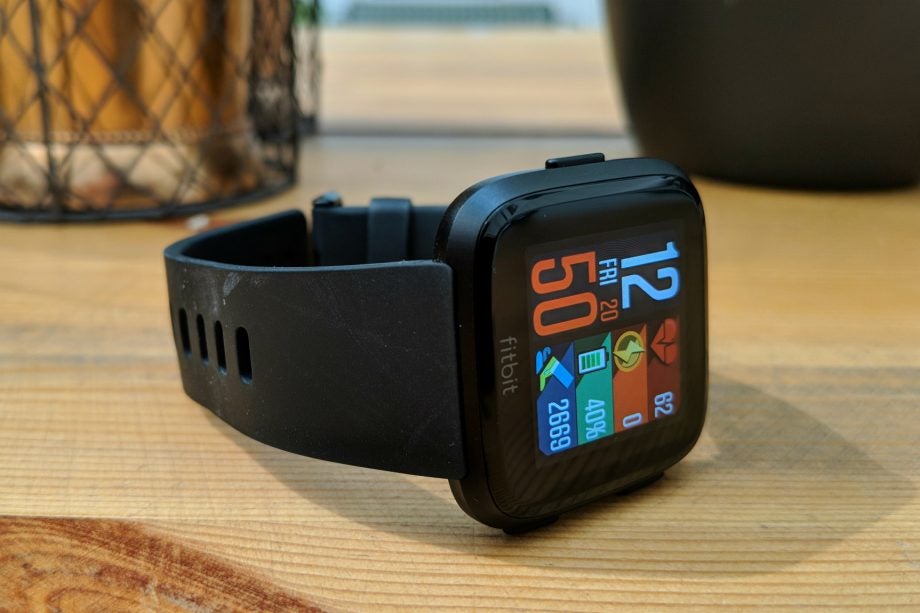
Verdict
The Fitbit Versa is the company's best smart watch yet, but it still needs work
Pros
- Excellent battery life
- Slick, comfortable design
- Lots of tracking options
- Swim-proof
- Bright, clear screen
Cons
- No built-in GPS
- Shortage of apps
- Passive notifications
Key Specifications
- Review Price: £199
- Heart rate monitor and relative SpO2 sensor
- 2.5GB onboard storage
- NFC
- Fitbit OS
- Water-resistant to 50m with swim tracking
- 1000 nits screen
What is the Fitbit Versa?
Fitbit’s second ever smartwatch, the Versa is a far cry from the Ionic, its slightly disappointing predecessor. Its outstanding battery life and slick design make it a genuine competitor to more expensive smartwatches including the Apple Watch 3, but the lack of in-built GPS is a big miss.
The Versa can help you keep tabs on a wide variety of activities, including running, swimming and cycling, and its menstrual cycle tracking is another hugely intriguing feature. Unlike many others smartwatches, it’s also compact enough to look good on users with slim wrists.
However, Fitbit needs to continue improving its smart features and app support in order to really make it shine.
Related: Fitbit Charge 3
Fitbit Versa – Design and display
The Fitbit Versa is unfussy but attractive. The rounded square design – or squircle, if you like – might not be to everyone’s taste, but most doubters will be able to get over that simply because of how sleek it looks.
Related: Best fitness tracker
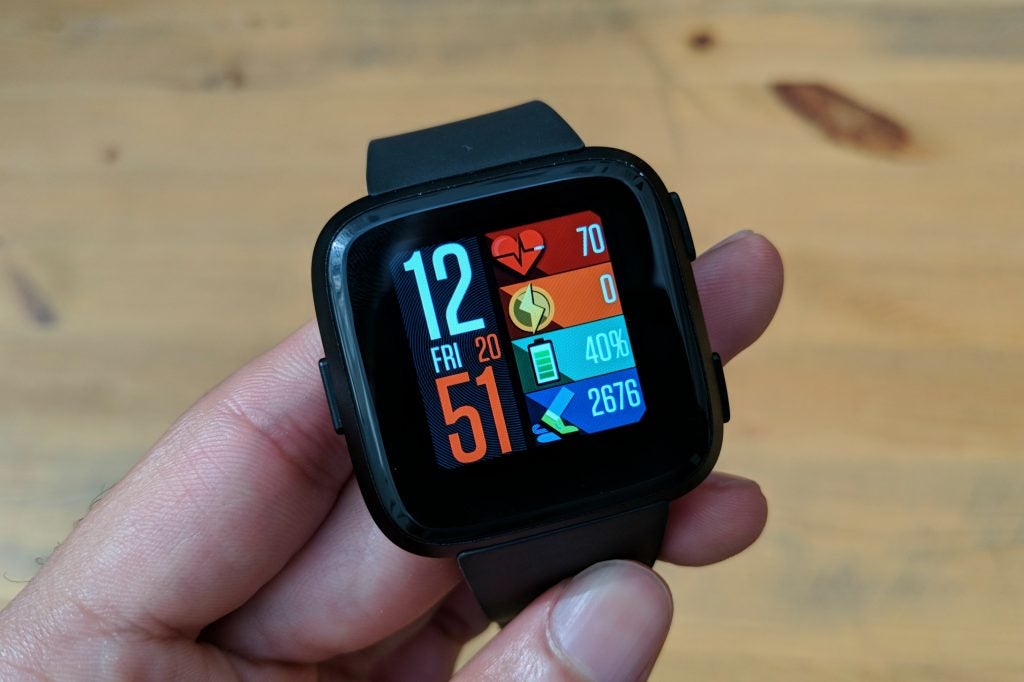
Unlike some other smartwatches, the Versa won’t dominate on your arm. Its aluminium body is slim, compact and comfortable to wear, sitting flat against your wrist. It looks far slicker than the clunky, angular Ionic.
Based on looks alone, the Ionic is quite obviously a fitness-orientated device. The Versa, on the other hand, feels far more polished and lifestyle-friendly.
From afar, you could easily mistake it for the Apple Watch. The most obvious differences are the physical buttons. Instead of a Digital Crown, the Versa has one key along its left-hand edge – to wake the screen or navigate backwards. There are two on its right, to quickly start, pause and end your workouts.
Our biggest design criticism concerns the bezel running around the Versa’s display. It’s thick, noticeably so. This can in part be attributed to the brightness and vibrancy of the smartwatch’s touchscreen. It tops out at 1000 nits, making it easy to read at all times, even in bright sunlight. It isn’t an always-on display, but you can wake it up with a wrist-flick, a press of the left-hand button, or a strong tap of your finger.
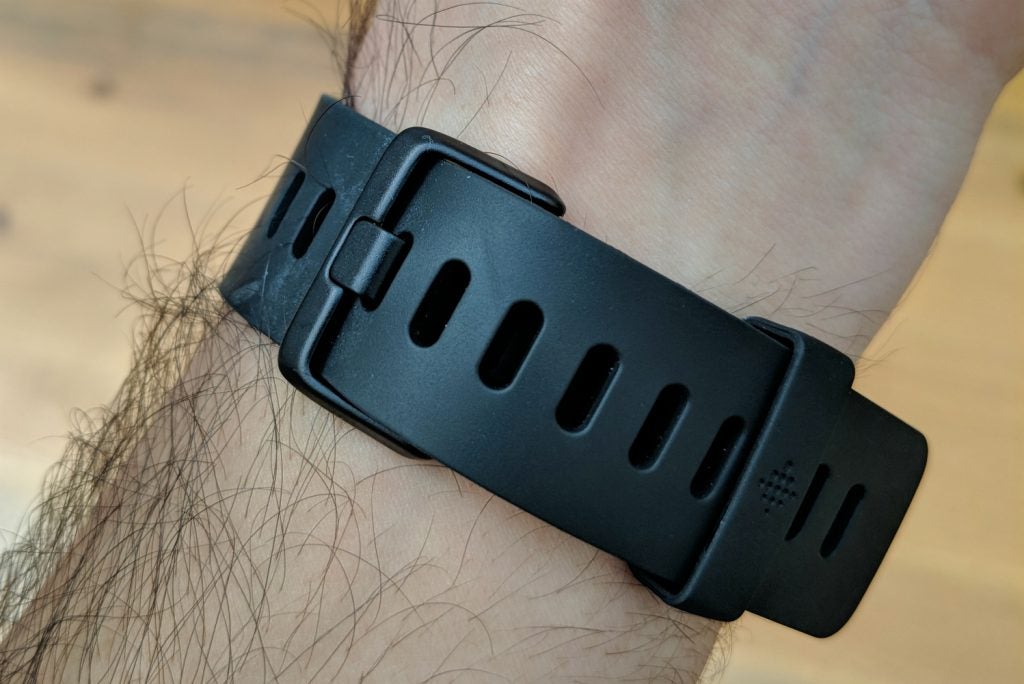
As well as black, the Versa is also available in silver and rose gold colour schemes, and there’s a range of silicone, leather, metal and woven bands from which to choose.
Fitbit Versa – Specs and sensors
Unlike the Ionic, the Versa doesn’t have GPS built-in. What this means is that, if you want to track your running route, you’ll need to take your phone out with you too. That’s a big deal, and it’s one of the main reasons the Versa costs so much less than the Ionic.
However, what the Versa does have is enough onboard storage for around 300 of your favourite songs, which you can play through a pair of Bluetooth headphones. This will allow you to go phone-free in the gym, which is great. For running, however, it makes more sense to play music through your handset, as you’ll probably have it with you anyway because of its GPS capabilities.
Related: Best smartwatch
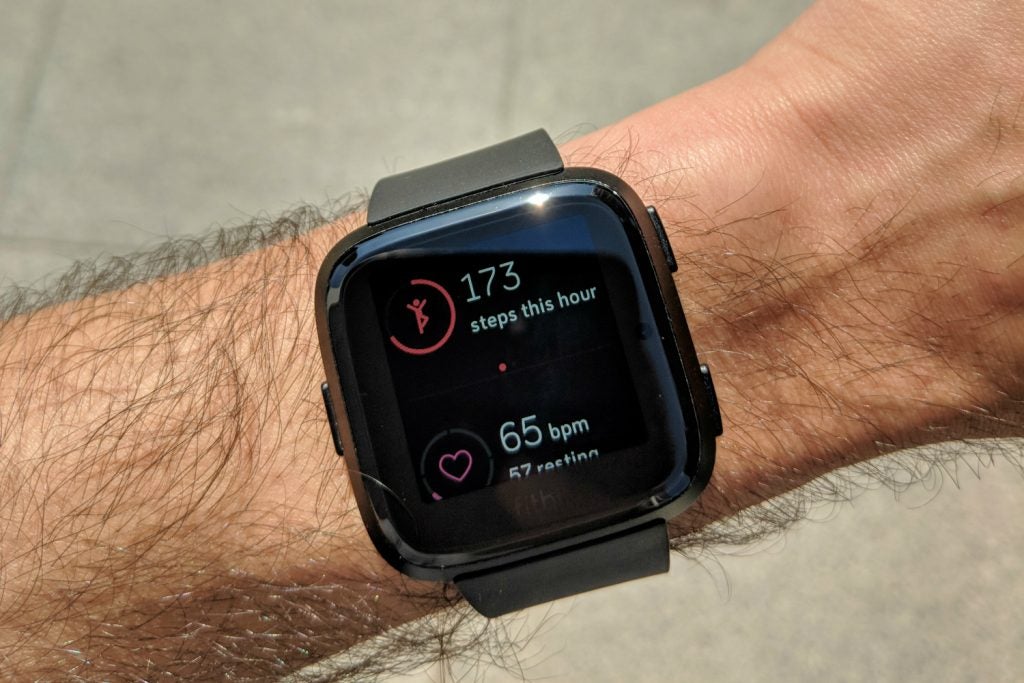
There’s an NFC chip onboard for contactless payments, but that’s very much a work in progress. Only Santander, Danske Bank, Starling Bank and Boon by Wirecard support Fitbit Pay in the UK right now. In the US, meanwhile, contactless payments are available on the Special Edition Versa, which costs $30 more than the standard model (and is available in charcoal and rose gold).
The Versa is also water-resistant to 50 metres, so you can wear it in the pool, and it does all of its tracking using a 3-axis accelerometer, 3-axis gyroscope, optical heart rate monitor and altimeter.
Fitbit Versa – Exercise and activity tracking
Those sensors enable the Versa to track a wide range of activities including running, swimming and cycling. It also tracks your walks and general workouts, such as weight-lifting and interval training, and monitors your steps, distance covered, floors climbed, calories burned, heart rate and sleep.
For anybody new to smartwatches, this may seem like an awful lot – but what’s key here is how straightforward the Versa is to use. It runs Fitbit OS 2.0, which is intuitive, simple to navigate and lets you access the watch’s key features with just a few swipes and taps.
To track a run, for instance, simply swipe left on the main screen, tap the exercise icon and select Run. For other types of exercise, you swipe through the tabs until you land on the right option. To begin tracking, hit the Play button, which you can tap again to pause tracking. You can bring an end to your workout by hitting the chequered flag icon.
To quickly view your stats for the day, including details of any workouts you’ve completed and your progress, just swipe up on the main screen.
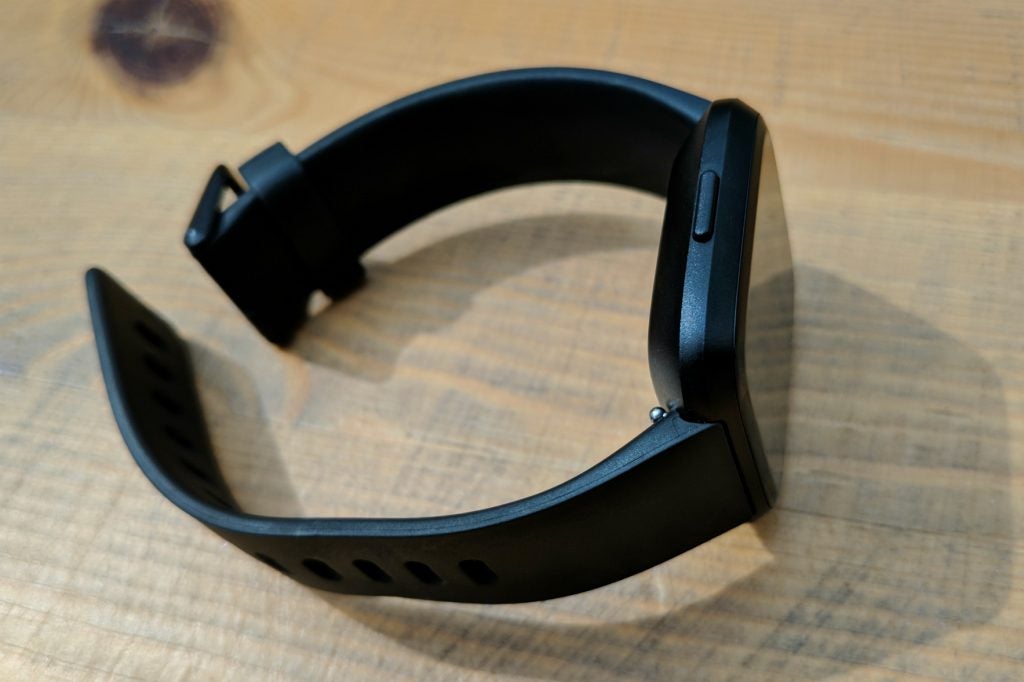
This simplicity is crucial, since it makes everything easy to find, which in turn makes the Versa both enjoyable to use and engaging. You can, of course, also set reminders and alerts for targets. However, as is the case with any smartwatch, these can feel aggressive at times, and sometimes a little irritating too.
As mentioned earlier in the review, the Versa doesn’t have GPS built in, so you’ll need to connect your phone to get a map of your running route – which you can then view in the Fitbit app.
While you’re running, the watch displays key information such as pace, time and distance, and you can swipe for additional information. Thanks to Run Detect, it automatically pauses tracking when you stop for a break, and resumes when you begin moving again. Regular gentle vibrations tell you when you’ve hit certain milestones mid-run too – at kilometer intervals, for example – so you don’t need to keep looking down at your wrist.
In the pool, the Versa automatically knows when you’ve finished one length and started another, though you first need to specify the length of the pool you’re swimming in. However, whatever you input will remain the default pool length.
If you switch from a 25m pool to a 50m one, for instance, you’ll need to remember to manually update your choice before you start swimming, in order to get the most accurate tracking data.
For open water swimming, the Versa will estimate the distance and number of lengths you’ve covered. You can find this data in the Fitbit app, as well as the number of calories you’ve burned and the impact of the session on your day.
Another handy feature this Fitbit offers is the ability to quickly measure yourself against other people. Inside the app, in the Heart Rate section, is a Cardio Fitness Score graphic, which is an estimate of your VO2 Max based on factors such as your heart rate, running pace, age and weight. The idea is to improve your score over time by exercising on a regular basis.
A competitive edge is provided by the related Cardio Fitness Level graphic, which shows you exactly where you stand compared to people of the same age and gender.
Similar comparisons are also available for sleep tracking. The Versa automatically monitors your sleep, using changes in your movement and heart rate to work out when you nodded off, and when you woke up.
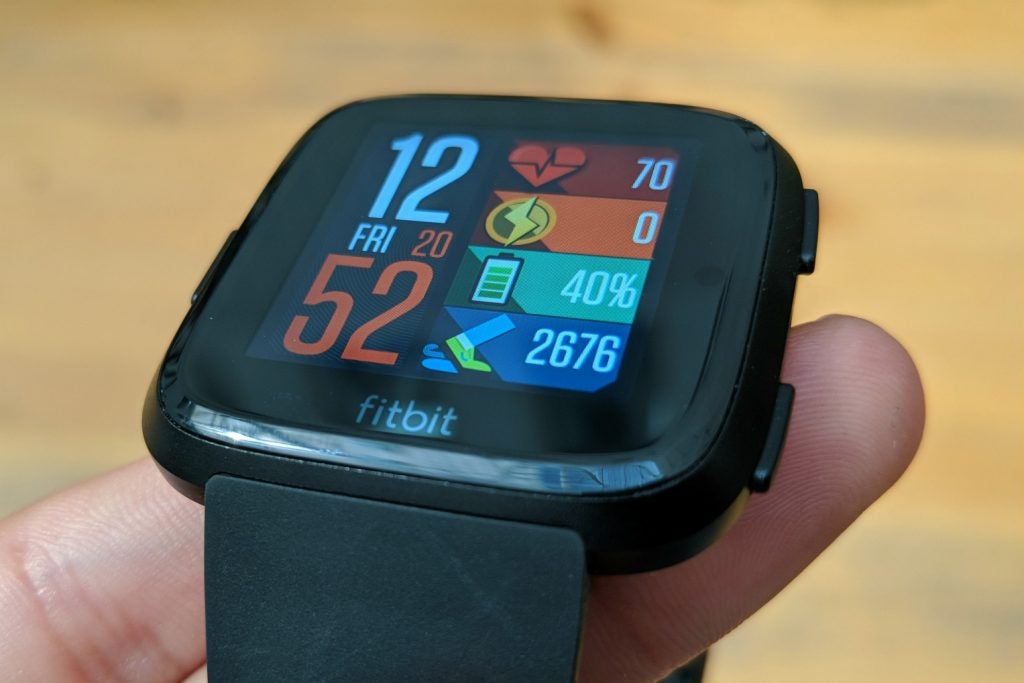
The Fitbit app displays this data in a graph that shows how long you’ve spent in each individual sleep phase: awake, REM, light and deep. Admittedly, this requires a degree of trust in Fitbit’s tracking capabilities on your part.
However, I tend to wake up several times each night and, over the course of this review, have been at least attempting to make a note of exactly when in the night this happens. Promisingly, my sleep graphs appear to match up with the periods of late-night consciousness that I’ve actually managed to successfully remember.
Once again, you can find out more about your sleeping patterns by swiping through the screens in the Sleep section of the app. Comparisons with other people your age are also easy to find, and encourage you to think about your bedtime routine and ways in which to improve it.
The Versa offers period tracking to all users aged 13 and older, though you need to opt in, in order to use it. To enable the feature, tap and hold a dashboard tile in the Fitbit app, then add the Female Health tile when it pops up.
You can log your periods, track where you are in your cycle, see when your next period is expected and view your upcoming estimated fertile window. It also shows you a breakdown of how your cycle and symptoms change on a monthly basis, and can deliver push notifications two days before and on the day of your predicted period start date.
The Versa also bundles in three different workouts − 10-Minute Abs, 7-Minute Workout, and Treasure Chest − which you can find inside the Coach app.
They’re really handy, with graphics on the screen guiding you through different routines and pushing you to work out as intensely as you can, with little resting time in between. What’s more, all of the exercises you’ll find in there can be done at home, in your living room.
Fitbit Versa – Smartwatch functionality
Many consumers will likely be weighing up the Versa primarily because of its fitness-focused features, but what should set it apart from cheaper fitness bands are its smart capabilities. However, this is where improvements need to be made.
The most obvious area of focus for Fitbit is the apps section. Quite simply, there aren’t very many useful apps to download and use on the Versa.
Deezer is perhaps the biggest of the bunch, but there’s an obvious issue here. If you already have an account with Spotify – Deezer’s much more popular rival – then you’re unlikely to create and also pay for a new Deezer account just so you can listen to music through your smartwatch. Furthermore, the fact that you need to have your phone with you to properly track your runs on the Versa makes the thought of using Deezer on the watch even less appealing.
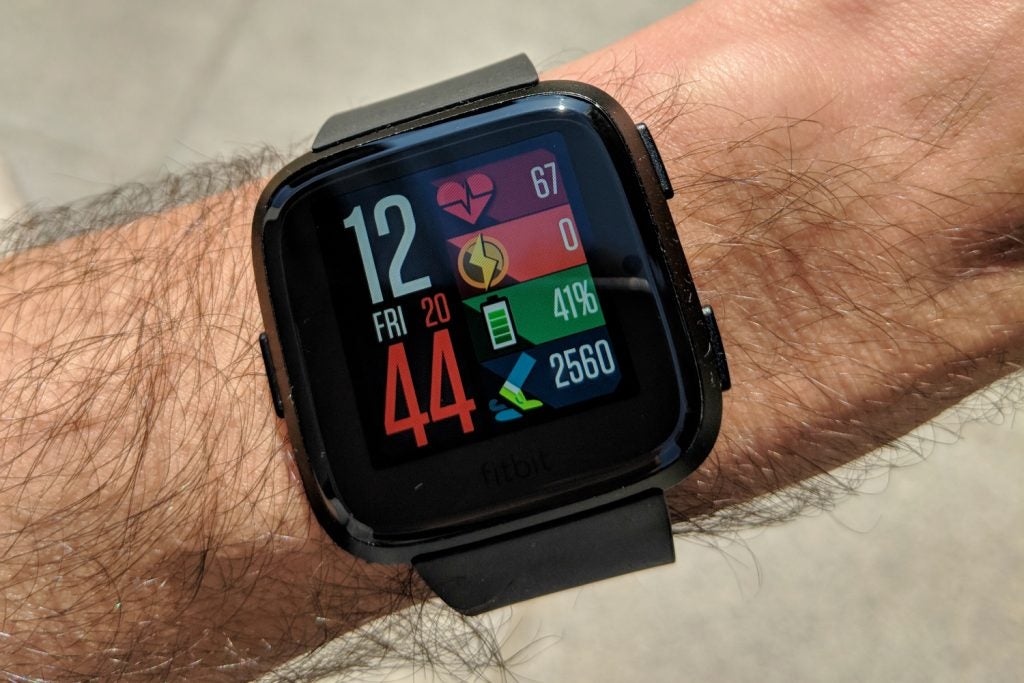
There’s also Strava, Hue Lights, Uber by Fitbit, Nest, Yelp and The New York Times, but those are the biggest names available right now. It’s a little like the Windows Phone app store at the moment – it isn’t totally bare, but major titles are few and far between. Fitbit has promised to roll out more apps to its smartwatch platform in the near future, but it needs to get a move on.
It’s a similar case with notifications, which at present feel half-baked. You can receive alerts on the Versa for calls, texts and events when the device is connected to your phone, but you can’t yet respond to them directly from the watch.
You expect such limitations on smart bands, but smartwatches are supposed to offer more. Once again, Fitbit needs to work quickly to add the extra functionality.
Otherwise, it’s pretty much as you’d expect. You can personalise the Versa’s look by browsing a wide range of clocks faces through the Fitbit app and, as mentioned earlier in the review, you can add songs to the watch and use it to make contactless payments (if your bank’s supported).
Fitbit Versa – Battery life
The Versa’s stamina truly puts other smartwatches in the shade. Fitbit says you can expect the watch to last for at least four days off a single charge, but real-life results show that to be a conservative estimate.
In testing, the Versa comfortably kept going beyond four days. When it was connected to my phone via Bluetooth, it lasted five days; when it was untethered, it managed six days. What’s more, if you want to extend that even further, you could set the screen’s brightness to dim rather than automatic or bright.

These are super-impressive figures, which pretty much put the Versa on an even keel with the Fitbit Ionic. However, most other smartwatches don’t come close. The Apple Watch, for instance, needs to be charged every night.
The Versa also comes with a clip-in charger, into which you place the watch by squeezing it open. From flat, you’ll be back up to 100% in around two hours.
Why buy the Fitbit Versa?
In many ways, the £199.99 Fitbit Versa is an improvement on the £279.99 Ionic. It’s far better-looking, more lifestyle-friendly and has a similar feature-set – and all of this comes wrapped up in a device that costs significantly less money.
You can use it to monitor a huge range of activities too, including swimming, and it’s easy to use. Battery life is another feather in its cap; most other smartwatches on the market don’t come close.
However, as an actual smartwatch it’s limited right now. This will hopefully change in the near future when Fitbit rolls out planned updates, but it might be worth waiting until those are released before buying the Versa. Currently, it feels like a work in progress. Some users will find the lack of apps frustrating, and it’s disappointing that we’re still having to wait for features that we expect from a smartwatch, such as quick replies to messages.
The lack of built-in GPS is also a big miss, and means you’ll be tethered to your phone when you’re out running. Although not the worst thing in the world, we’d prefer it not to be necessary.
The Versa is undoubtedly a step up from the Blaze, but right now it feels like a smartwatch for casual users who are looking to make small improvements to their lifestyle and try a smartwatch for the first time. With that in mind, serious runners would be better to consider the Ionic, or the slightly more expensive – but more attractive – Apple Watch Series 3 GPS.
Verdict
There’s plenty to like about the Versa, from its generous range of tracking capabilities to its slick design and outstanding battery life, but Fitbit needs to improve its smart capabilities and app selection.


